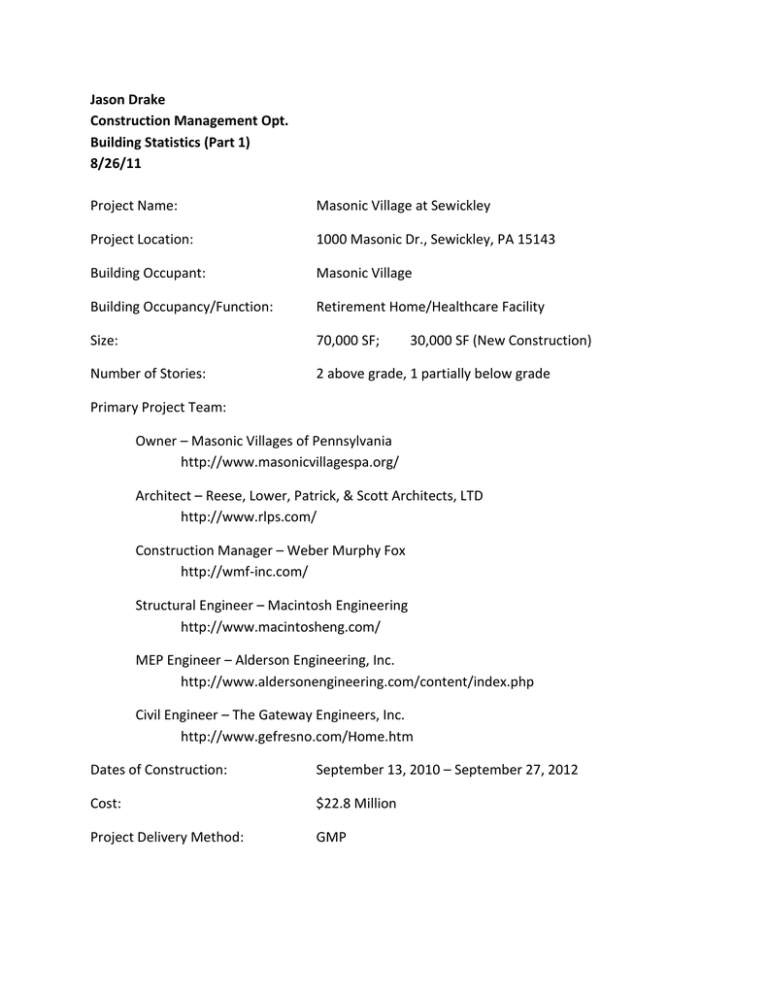Building Statistics (Part 1)
advertisement

Jason Drake Construction Management Opt. Building Statistics (Part 1) 8/26/11 Project Name: Masonic Village at Sewickley Project Location: 1000 Masonic Dr., Sewickley, PA 15143 Building Occupant: Masonic Village Building Occupancy/Function: Retirement Home/Healthcare Facility Size: 70,000 SF; Number of Stories: 2 above grade, 1 partially below grade 30,000 SF (New Construction) Primary Project Team: Owner – Masonic Villages of Pennsylvania http://www.masonicvillagespa.org/ Architect – Reese, Lower, Patrick, & Scott Architects, LTD http://www.rlps.com/ Construction Manager – Weber Murphy Fox http://wmf-inc.com/ Structural Engineer – Macintosh Engineering http://www.macintosheng.com/ MEP Engineer – Alderson Engineering, Inc. http://www.aldersonengineering.com/content/index.php Civil Engineer – The Gateway Engineers, Inc. http://www.gefresno.com/Home.htm Dates of Construction: September 13, 2010 – September 27, 2012 Cost: $22.8 Million Project Delivery Method: GMP Photo 1: Existing South Wall Architecture: The history of Masonic Village at Sewickley is relatively young. The organization has occupied the property since 1999 when the campus was purchased from the Valley Care Association. Masonic Village envisioned establishing a superior retirement care community. Since their possession of the property, a 60 apartment personal care facility and a 227 retirement living apartment building with 43 villas has been constructed. Each expansion indirectly proves their exceptional ability to satisfy the needs of their residents. The skilled care facility additions of Masonic Village at Sewickley are comprised of two distinct wings, which branch out from the structure’s existing central core. Thus far the building’s southern wall has been straight and square, plainly stretching across the entire length of the building. Both of the two major additions, the east and west wings, take the shape of an elongated semi-circle that each connect back into the structure’s south wall at two distinct points. Although the building’s walls are not actually rounded, the additions effectively form two unique courtyards within the centers of what has now become a figure eight. Each wing is comprised of two floors above grade. However, the east wing contains one floor that is partially below grade. The small floor below grade serves the function of housing the building’s MEP equipment, whereas the two upper floors of the addition provide private bed spaces for patients. Masonic Village’s central core, located at the centroid of the two protruding wings, provides a public gathering space for visiting, resident entertainment, and other social events. The primary reason for the building’s figure eight shape, as opposed to one solid block, is due to the positioning of patient rooms. Resident rooms are positioned along the interior of each loop. According to code, each resident is to be provided with an exterior window. Since each wing laps back along the south wall, courtyards were added as a buffer, providing light-wells for individuals residing at the building’s core. Zoning for Masonic Village at Sewickley is classified under industrial/commercial. Given the size of site, developers had virtually no problem keeping building lines well within required setbacks. Furthermore, the excessive size of the property made it very easy to satisfy zoning requirements in regards to the desired number of parking spaces for the building. Building Enclosure: The building façade is mostly made up of a brick veneer. It contains a kiln fired thin brick that is 2 1/4”x 7 5/8” nominal size. Colored mortar is used within the joints to accent the shade of the brick. Although the building is almost entirely brick, there are a few smaller areas in which other exterior sidings are used. Contained within the peaks of a few roof gables is the implementation of cellular P.V.C. cedar panel siding. The siding is wood grained in texture and integrally colored with the building’s brick veneer. A cellular vinyl siding with 6” exposure can also be identified on the second floor wall in some small areas as well. However, these regions maintain a horizontal layout in single board style and differ from the cedar texture of the roof gables. Double hung windows with a nine square pattern are common on the building’s exterior as well as hollow core metal doors at many of the exits. Two distinct type of roofing materials are used in the project. The building’s existing roof is made up of an EPDM roofing membrane. Much of the old material will be removed during construction and replaced by a new fully adhered EPDM membrane on top of tapered insulation or rigid insulation. The newly added wings of the building account for the second type of roofing material used on the project. Both areas are topped with gabled roofs. These regions will be covered with glass-fiber reinforced asphalt shingles. The shingles are to be of standard size with granules treated to resist any potential algae discoloration.


